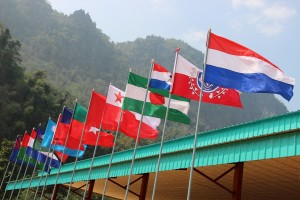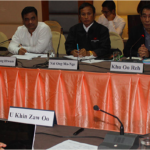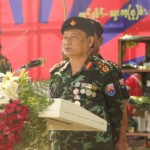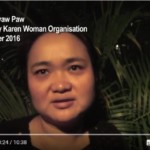By Banya Hongsar for Mon News Agency (MNA) | June 01, 2016
The politics of alliance has never been defined in its own narrative within the ethnic writer and scholar in modern political literature in English. However, it has been well written in Burmese and other ethnic languages in the country. It is a complex issue to be explored by a non-ethnic writer in depth, to understand its rhetoric and substance due to the hidden agenda of political interests within the ethnic political factions in the country. It is far more complex than a simple word like ‘democracy’. As widely used as it is in modern Burmese political literature, at least the subject is not an isolated matter to many journalists and writers in Burma, also known as Myanmar, regardless of their/our insightful knowledge on the issue.
The issue could go back to the early 1940s and up to the late 1970s, prior to a popular uprising for a democratic movement in 1988. This commentary is a raw piece to the reader of Mon News in the case the issue is a worthy matter to be debated in the context of national unity and reconciliation within the delivered people of Myanmar. This is a debate ongoing in Myanmar’s modern political transition after a newly elected civilian government rules the country for first time after the Second World War.

ethnic groups’ flags seen flying by one another (Photo: Karen News)
Electoral political alliances:
An Electoral Alliance among the 60 Ethnic Parties was formed by the United Nationalities Alliance (UNA): 8 ethnic parties loosely allied to the NLD – dating back to 1990, Nationalities Brotherhood Federation (NBF): of the 23 ethnic parties – formed in January 2001, Federal Democratic Alliance (FDA) and another 9 (possibly 10) ethnic parties – formed in January 2014 as an alternative political force to the ethnic people while the country is seeking to restore peace. It has been a long peace process in the country initiative since the early 1990s but it failed to sustain energy until the late 2010s. In addition to the NDF, the FDA will consist of the Democratic Party (Myanmar), Democracy and Peace Party, Party for Unity and Peace, Union Democratic Party, Kayin (Karen) People’s Party, Peace and Diversity Party, United Democratic Party, and Chin Development Party.
Historically, the armed insurgency built the alliance in a different time for a different purpose and can be dated back to 1970 when the exiled Prime Minister U Nu had contacted the Karen and Mon insurgency leaders on the Thailand border. Subsequently, they formed a political alliance known as ‘ta –nya-la’ in Burmese, translated literally in English as ‘National Unity and Liberation Front’. However, the alliance only served a short-term purpose when the front was dismantled in the late 1980s and U Nu fled to India for sanctuary. However, ethnic armed insurgency leaders found their own ways in times of need when they were united for a common purpose; on the fighting for liberation.
Ethnic leaders, in both camps of armed insurgencies and non-armed political forces use the word ‘alliance’ in Burmese as ‘ma-ha-mitt’. In particular, for every forum they meet and hold dialogue as an ever critical strategic factor in a campaign against the Bamar’s military rules and other political establishments in this half of the century. They formed different alliances in different times for different purposes in both political and military terms.
New armed ethnic alliance:
There are a few names to be recalled in the past thirty years. The popular names were formed under; National Democratic Front, and United Nationalities Federal Council by the armed insurgencies and United Nationalized Alliance by the non-armed ethnic political forces. There were more sub-alliances within ethnic armed forces as well as ethnic political establishments during post-1990s in order to seek protection and aid in emergencies. In post 2010, there are newly emerged alliances such as Ethnic Brotherhood Alliance / Forum by newly registered political parties in the country. The list is about to be named a visible establishment in the public arena. The rhetoric and substance shall be examined to this establishment in the context of political transition, at least to the self-proclaimed ‘self-determination’ at large by these ethnic leaders.
According to a report from the Irrawaddy in July 2015, almost 50 ethnic parties from the Nationalities Brotherhood Federation (NBF), United Nationalities Alliance (UNA) and Federal Democracy Alliance (FDA) could potentially be competing within their respective coalitions, as well as against the country’s two biggest political parties in November. However, these three alliances have different interests and approaches to the electoral campaign because the leaders are well connected to either the armed ethnic and non-armed ethnic professionals within the Government circle including personal connection with the National League for Democracy.
In theory, the alliance is a matter of choice, not a principle of political objective to the ethnic leaders in terms of armed insurgencies against the previous military government from the late 1950s to the late 2010s. In practice, the ethnic leaders have fewer avenues in defending its own controlled areas unless they are co-operating with each other’s troops when the previous government attacked the front lines of ethnic territory. However, government’s troops mostly attacked and occupied headquarters of the ethnic armed groups when they determined the battle shall be won regardless of the price they have to pay for and brutally attacked the ethnic armed groups with many casualties.
Two battles in the Karen controlled zone shall be a reminder to the ethnic alliance. The first mass battle field on Maw Pho Kee in 1983 – 1987 and the second heavy fighting between the Government’s troops at the Mah Nae Palaw during the 1990s. It took less than seven days for the government troops to attack and occupy Three Pagoda Pass, controlled by the Mon insurgency in 1991. There were cases in Kachin and Shan State but the battle was always won by the government’s troops with heavy losses.
Nevertheless, armed ethnic leaders maintain their own rhetoric and substance despite the hope derived from the memorandum of understanding (MOU), there isn’t enough proof to say its core objectives are effective. The Karen and Mon ethnic armed leaders shared pain in the 1988 battle and also distrust between them in late 1994 when the Karen armed leaders secretly signed the first ‘cease-fire’ agreement without prior knowledge of the New Mon State Party. History is marked in ‘black ink’, but the Karen and Mon leaders reunited again in 1997 at the Mae Tha Raw Hta conference.
In recent months, different frameworks for political dialogue have been drafted by the UNA representing 12 ethnic parties and also by the United Nationalities Federal Council which represents 11 armed groups. A third has been written by the 56 political parties led by the Nationalities Brotherhood Federation, an alliance of ethnic parties, reported Lu Min Maung in July 2015. This report displayed that the non-armed ethnic leaders and armed ethnic leaders hold different views and principles regarding political conflict resolutions within themselves but the common goal is equally placed ‘peace’ in the entire country.
This article originally appeared on Mon News Agency on June 01, 2016.
The views expressed in this article are the authors own, and may or may not reflect those of Burma Link.







